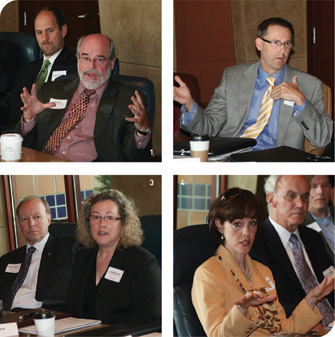
1. Hannes Zacharias spoke as both Johnson County goverment’s top administrator and from the perspective of someone managing programs for more than half a million residents. | 2. Mark Avery cited the lack of a severability clause as potential grounds for overturn of the federal health-care law, suggesting that if any of it is overturned by the Supreme Court, the entire law would be, as well. | 3. Lynn Duncan said the corporate culture at Layne Christensen was changing to embrace a mindset of improved health among the employees. | 4. As a physician in a free health-care clinic, Bridget McCandless said that while she is seeing more uninsured patients, there’s been an increase in those who are taking better care of themselves, too.
Hannes Zacharias, county manager for the 4,000-employee Johnson County, has two worries about the effect of legislation: one is the health of his employees; the other is the health of the citizens of Johnson County. As to the former, he noted, “I don’t see us dumping employees on the health-care exchange, but I want to be sure we provide good health care.”
Wellness Strategies
According to Carolyn Watley, some of the smaller employers CBIZ consults with are clearly thinking about dropping coverage, but the larger employers will likely continue to offer coverage, including CBIZ itself.
“You know there’s going to be additional costs,” said Watley. “You know it’s going to be more complicated, and so, with all the regulatory things happening, you set that aside and deal with what is.” One response she is seeing among CBIZ clients is an emphasis on wellness.
At Layne Christensen, a water and energy exploration company headquartered in Johnson County, the CEO is committed to wellness as a cost-cutting strategy. “We haven’t really seen the dollar savings yet,” said Lynn Duncan. “It’s too early to tell, but this culture is part of our offices all over the United States.”
Individual Mandates
The part of the reform package referred to as the “individual mandate” dictates that those individuals who do not purchase minimum coverage are fined under the shared responsibility rules. “Were the court to say the individual mandate goes away but he rest of the bill remains intact,” asked Rick Kahle, “what happens from an insurer’s perspective?”
“That’s one of my greatest fears,” said Keith Wisdom, vice president of account management for United Healthcare. “If the mandate isn’t there, the individual costs will skyrocket.” Wisdom observed that the health-care system is being seriously disrupted by the reform and would be disrupted even more “if the bill gets torn apart.”
Mark Avery argued that the bill’s lack of a severability clause would mean that if one part were found unconstitutional, the whole bill would likely be thrown out.
Ed Fensholt had a different take on the law. “I’d be a little surprised if the Supreme Court would toss the entire thing out in the wake of a ruling that the individual mandate is unconstitutional,” he said. “I’d like to see it, but I don’t think it’s going to happen.”
The Newly Eligible
Rick Kahle asked his colleagues what kind of impact they anticipated from those individuals who would be eligible for coverage for the first time.
On the down side, Bridget McCandless, a physician who is CEO of the Share Care Free Clinic and president of Metropolitan Medical Society of Kansas City, is seeing more of the uninsured, a population she expects will grow as small businesses drop insurance coverage. On the plus side, the people she is seeing are more focused on being well than she has seen in the past.
In 2014, when the newly covered hit the system, McCandless anticipates a huge wave at the beginning. “I think you’re going to see some frustration,” she said, ‘because the number of providers available to take new patients is extraordinarily low.”
Tom Franzen, finance director and county treasurer for Johnson County, expressed concern about the effect of an additional 30 to 40 million participants on the system. “We’re not sure how that is ultimately going to impact the service-delivery model that we currently utilize,” he noted.